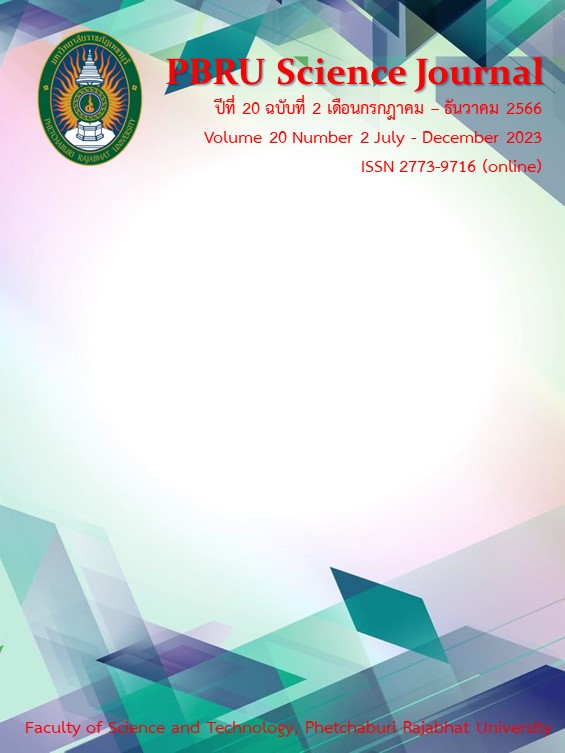ผลิตภัณฑ์น้ำสลัดครีมจากเต้าหู้ถั่วเหลืองเสริมไข่ผำแห้ง
Main Article Content
บทคัดย่อ
น้ำสลัดครีมเป็นเครื่องปรุงเพื่อเพิ่มความอยากอาหารของผู้บริโภค ในปัจจุบันผู้บริโภคตระหนักถึงผลของการบริโภคไขมันในไข่แดงและไขมันที่ใช้ในน้ำสลัด การศึกษานี้มีวัตถุประสงค์เพื่อพัฒนาน้ำสลัดครีมไร้ไข่แดงด้วยเต้าหู้ถั่วเหลืองและเติมแซนแทนกัม เพื่อทดแทนเต้าหู้บางส่วนและเพิ่มความคงตัวของน้ำสลัดครีม โดยศึกษาปริมาณแซนแทนกัมที่เหมาะสมในผลิตภัณฑ์น้ำสลัดครีมจากเต้าหู้ (ร้อยละ 0.15, 0.30 และ 0.45) และเสริมไข่ผำแห้ง เพื่อเพิ่มคุณค่าทางโภชนาการในน้ำสลัดครีม (ร้อยละ 1.0, 2.0 และ 3.0) จากการศึกษาพบว่าการทดแทนเต้าหู้ด้วยแซนแทนกัมในน้ำสลัดครีมจากเต้าหู้ ที่ร้อยละ 0.30 ได้รับคะแนนความชอบด้านเนื้อสัมผัสและความชอบโดยรวมสูงกว่าสูตรอื่นและมีค่าสี ค่าความหนืด และค่าการไหลใกล้เคียงกับตัวอย่างควบคุมมากที่สุด จึงถูกนำไปพัฒนาผลิตภัณฑ์ โดยการเสริมไข่ผำแห้ง จากการวิจัยพบว่าการเสริมไข่ผำแห้งร้อยละ 1.0 ผู้ทดสอบชิมให้คะแนนความชอบด้านลักษณะปรากฏ สี รสชาติ เนื้อสัมผัส และความชอบโดยรวม สูงกว่าสูตรอื่นและอยู่ในระดับชอบปานกลางถึงชอบมาก อีกทั้งการเสริมไข่ผำแห้งในน้ำสลัดปริมาณมากส่งผลให้ค่าความสว่าง (L*), ค่าดัชนีสีแดง (a*) และค่าการไหลของน้ำสลัดครีมมีค่าลดลง ในขณะค่าดัชนีสีเหลือง (b*) และความหนืดของตัวอย่างสูงขึ้น ซึ่งส่งผลต่อการประเมินทางประสาทสัมผัสของผู้ทดสอบชิม ผลการวิจัยนี้ชี้ให้เห็นถึงศักยภาพในการใช้แซนแทนกัมและไข่ผำทดแทนไข่แดงในน้ำสลัดครีมจากเต้าหู้
Article Details

อนุญาตภายใต้เงื่อนไข Creative Commons Attribution-NonCommercial-NoDerivatives 4.0 International License.
บทความที่ได้รับการตีพิมพ์เป็นลิขสิทธิ์ของ PBRU Science Journal
เอกสารอ้างอิง
Babajide JM, Olatunde OO. Proximate composition, rheology and sensory qualities of corn–cocoyam salad cream. World J dairy food sci 2010;5:25-9.
Wu JH, Chang YK, Hou YC, Chiu WJ, Chen JR, Chen ST, et al. Meat-fat dietary pattern may increase the risk of breast cancer-A case–control study in Taiwan. Tzu Chi Med J 2013;25:233-8.
Liu R, Tian Z, Song Y, Wu T, Su W, Zhang M. Optimization of the production of microparticulated egg white proteins as fat mimetic in salad dressings using uniform design. Food Sci Technol Res 2013;24: 817-27.
Ma Z, Boyeb JI. Optimization of lentil-supplemented salad dressings as affected by type and level of hydrocolloids by response surface methodology. MOJ Food Process Technol 2016;2:55-65.
Liu K, Soybeans: Chemistry, Technology and Utilization. Gaithersburg, Maryland: Aspen publishers; 1999.
Erdman JW, Stillman RJ, Boileau RA. Provocative relation between soy and bone maintenance. Am J Clin Nutr 2000. Sep;72:679-80.
Thawornkuno C. Soy isoflavones: Biochemistry, mechanism of action and implication for breast cancer preventions. Thai J Genet 2014;7:7-15.
Food and Drug Administration. Food labeling: health claims; soy protein and coronary heart disease. Fed Regist, 1999;64:57700-33.
พรทวี ธนสัมบัณณ์, สุวรรณา พิชัยยงค์วงศ์ดี. การใช้ประโยชน์จากปลายข้าวเป็นสารทดแทนไขมัน ในผลิตภัณฑ์น้ำสลัดเต้าหู้พลังงานต่ำ. วารสารสุขภาพอาหารและวิทยาศาสตร์สิ่งแวดล้อมชีวภาพ 2560;10:105-28.
Sirison J, Rirermwong A, Tanwisuit N, Meaksan T. Salad cream formulated with tofu and coconut oil. Br Food J 2017;119:2194-202.
Ma Z, Boye JI, Fortin J, Simpson BK, Prasher SO. Rheological, physical stability, microstructural and sensory properties of salad dressings supplemented with raw and thermally treated lentil flours. J Food Eng 2013;116:862–72.
McClements DJ. Emulsion ingredients. In: McClements, DJ. (Ed.), Food Emulsions Principles, Practices, and Techniques. CRC Press, Boca Raton (Chapter4). 2005.
Casas JA, Santos VE, Garcıa-Ochoa F. Xanthan gum production under several operational conditions: molecular structure and rheological properties. Enzyme Microb Technol 2000;26:282–91.
Sun C, Gunasekaran S, Richards MP. Effect of xanthan gum on physicochemical properties of whey protein isolate stabilized oil-in-water emulsions. Food Hydrocoll 2017;21:555-64.
Appenroth KJ, Sree KS, Bog M, Ecker J, Seeliger C, Böhm V, et al. Nutritional Value of the Duckweed Species of the Genus Wolffia (Lemnaceae) as Human Food Front Chem 2018;6:483.
Van Hoeck A, Horemans N, Monsieurs P, Cao HX, Vandenhove H, Blust R. The first draft genome of the aquatic model plant Lemna minor opens the route for future stress physiology research and biotechnological applications. Biotechnol Biofuels 2015;8:12-3.
Sree KS, Bog M, Appenroth KJ. Taxonomy of duckweeds (Lemnaceae), potential new crop plants. EJFA 2016;28:291-302.
Anthonius C, Seok Kian Yong A, Fui CF. Supplementation of duckweed diet and citric acid on growth performance, feed utilization, digestibility and phosphorus utilization of TGGG hybrid grouper (Epinephelus fuscoguttatus x Epinephelus lanceolatus) juvenile. SJST, 2018;40:1009-16.
De Beukelaar MFA, Zeinstra GG, Mes JJ, Fischer ARH. Duckweed as human food. The influence of meal context and information on duckweed acceptability of Dutch consumers. Food Qual Prefer 2019;71:76–86.
Radocaj O, Dimic E, Diosady LL, Vujasinovic V. Optimizing the texture attributes of a fat-based spread using instrumental measurements. J Texture Stud 2011;42:394-403.
Manakla S, Jareonnon P, Lilitchan S. Effects of xanthan gum on physicochemical and sensory properties of black sesame spreads. Food Appl Biosci J 2019;7:41-52.
Guarda A, Rosell CM, Benedito C, Galotto MJ. Different hydrocolloids as bread improvers and antistaling agents. Food Hydrocoll 2004;18:241-7.
Urlacher B, Noble O. Xanthan In A Imeson (Ed.), Thickening and gelling agents for food (pp. 284–311). London: Chapman & Hall 1997.
Garti N, Reichman D. Hydrocolloids as food emulsifiers and stabilizers. Food Struct 1993;12:411-26.
Sahin H, Ozdemir F. Effect of some hydrocolloids on the rheological properties of different formulated ketchups. Food Hydrocoll 2004;18:1015–22.
Abedinzadeh S, Torbati M, Azadmard-Damirchi S. Some qualitative and rheological properties of virgin olive oil- apple vinegar salad dressing stabilized with xanthan gum. Adv Pharm Bull 2016;6:597-606.
บุศราภา ลีละวัฒน์, ไตรรัตน์ แก้วสะอาด. การพัฒนาน้ำสลัดไขมันต่ำเสริมแป้งข้าวก่ำ. วารสารวิทยาศาสตร์และเทคโนโลยี 2561;28:774-89.
Khouryieh H, Puli G, Williams K, Aramouni F. Effects of xanthan-locust bean gum mixtures on the physicochemical properties and oxidative stability of whey protein stabilised oil-in-water emulsions. Food Chem 2015;167:340-8.
Pannuana O, Lertworasirikul S. Effect of different pretreatments on drying characteristics, color and chlorophyll contents of duckweeds (Wolffia globosa). The 60th Kasetsart University Annual Conference. “Next Normal Kasetsart: Turning crisis into sustainability”. 22-23 February 2022. Bangkok.
Bellomo MG, Fallico B, Muratore G. Stability of pigments and oil in pistachio kernels during storage. Int J Food Sci Technol 2009;44:2358-64.
Xu J, Shen Y, Zheng Y, Smith G, Sun SS, Wang D, et al. Duckweed (Lemnaceae) for potentially nutritious human food: A review. Food Rev Int 2009.
Chakrabarti R, Clark WD, Sharma JG, Goswami RK, Shrivastav AK, Tocher DR. Mass production of Lemna minor and Its amino acid and fatty acid profiles. Front Chem 2018;6:1-16.
Di Stefano E, Agyei D, Njokun EN, Udenigwe CC. Plant RuBisCo: An underutilized protein for food applications. J Am Oil Chem Soc 2018;95:1063-74.

